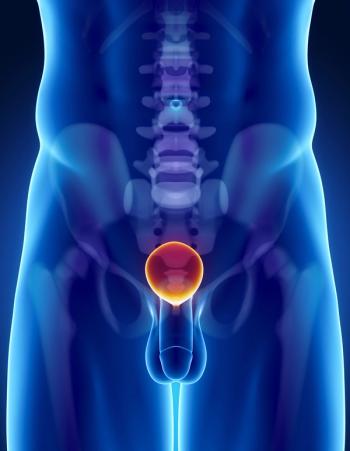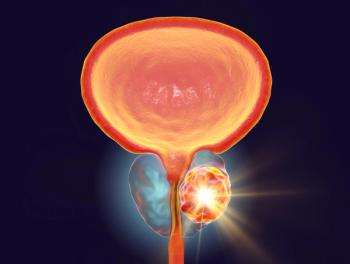
Oncology NEWS International
- Oncology NEWS International Vol 5 No 8
- Volume 5
- Issue 8
Chemo Improves Pain Relief in Advanced Prostate Cancer
PHILADELPHIA--Although the addition of chemotherapy to supportive care with a corticosteroid provides no survival advantage for patients with hormone-refractory prostate cancer, the combination appears to achieve better pain control, compared with corticosteroid therapy alone.
PHILADELPHIA--Although the addition of chemotherapy to supportivecare with a corticosteroid provides no survival advantage forpatients with hormone-refractory prostate cancer, the combinationappears to achieve better pain control, compared with corticosteroidtherapy alone.
The finding, from a phase III Cancer and Leukemia Group B (CALGB)study comparing hydrocortisone with or without mitoxantrone (Novantrone),supports earlier results from a pivotal phase III Canadian trialcomparing prednisone with or without mitoxantrone.
In his presentation of the CALGB preliminary results at the AmericanSociety of Clinical Oncology (ASCO) annual meeting, Phillip W.Kantoff, MD, of the Dana-Farber Cancer Institute, explained thatthe two trials used different primary endpoints.
Palliation and Survival Endpoints
`The Canadian trial (J Clin Oncol 14:1756-1764, 1996), conductedat 11 cancer centers with 161 patients, used palliative responseas the primary endpoint, whereas the CALGB trial, involving 242patients at 62 cancer centers, used survival, with quality oflife, as measured by five different instruments, as a secondaryendpoint.
In the pivotal trial, clinical benefit, defined as reduced painor reduced analgesic use, was seen in 38% of the combination therapygroup versus 21% of the prednisone-alone group. Median durationof pain relief was 8 months among patients who responded to combinationtherapy versus 2 months in the single-agent group.
Immunex Corporation, the maker of Novantrone, has filed thesedata with the Food and Drug Administration to receive priorityreview for use of the drug in hormone-refractory prostate cancer.
Dr. Kantoff reported that the CALGB study demonstrated a generaltrend toward a greater quality of life benefit with the chemotherapyregimen, with two parameters reaching statistical significance:intensity of pain and duration of pain.
As in the pivotal study, chemotherapy was well tolerated. "Grade3 to 4 granulo-cytopenia was frequently encountered in the mitoxantronetherapy arm," Dr. Kantoff said, "but only 2% of patientson mitoxantrone developed grade 3 or higher cardiotoxicity, andthere were no treatment-related deaths reported in either treatmentarm."
In the CALGB study, patients were randomized to receive hydrocortisone,40 mg/day, alone or with mitoxantrone, 14 mg/m² given intravenouslyevery 21 days. Treatment continued until disease progression orlimiting drug toxicity, or to a maximum mitoxantrone dose of 160mg/m².
PSA Decline
In the hydrocortisone-alone arm, 18% of patients had a PSA declineof greater than 50%, compared with 33% in the combination therapyarm, a statistically significant difference in response, Dr. Kantoffreported.
There was a borderline significant benefit for the combinationarm in time to treatment failure. However, he said, there wasno significant difference in overall survival (median, 11.8 monthsfor hydrocortisone alone versus 10.9 months for the combinationarm).
"The results are interesting," Dr. Kantoff said, "andtogether with the Canadian data from Dr. Ian Tannock and his colleagues,the findings support the use of hydrocortisone plus mitoxantronefor the palliation of patients with hormone-refractory prostatecancer." He added, however, that the results "are notsufficiently compelling to regard this combination as a standardof care."
Articles in this issue
over 29 years ago
NCCR Urges Congress to Support Senate Bill for Cancer Researchover 29 years ago
Researchers Propose New Treatment Guidelines for HIVover 29 years ago
Salvage Cryotherapy for Prostate Cancer Studied at M.D. Andersonover 29 years ago
FNA Dropped From RDOG Study Due To High Rate of Insufficient Samplesover 29 years ago
New Thinking on HIV Progression Leads to New Strategiesover 29 years ago
Hospitals Told Not to Capitate for 'Wrong' Reasonsover 29 years ago
More Study Needed of Possible Carcinogenesis of Winter Gas Additiveover 29 years ago
President Makes NCAB Appointmentsover 29 years ago
Algorithm Identifies Women at Risk of Ovarian CancerNewsletter
Stay up to date on recent advances in the multidisciplinary approach to cancer.

















































































